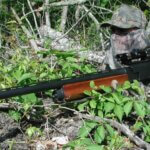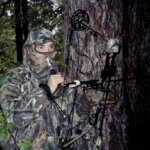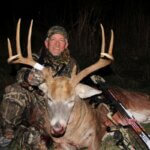Editor’s Note: Many deer hunters today are exploring shooting muzzleloaders like their ancestors did to hunt deer. You need to check the state’s regulations where you plan to hunt, because the rules vary from state to state. Some states offer muzzleloading-only seasons or allow muzzleloading during their primitive weapons’ seasons. Some states that don’t allow muzzleloading still may allow muzzleloading for various big-game species on specific WMAs. Some states have specific rules governing the use of pelletized powders, scopes, 209 primers, sabot and enclosed ignition. Arizona is considered one of the most relaxed states for muzzleloading laws. Consider muzzleloader hunting for deer to enjoy yet another facet of the outdoors.
Moving into the thickets may be the most-effective way to hunt public lands during blackpowder season. But according to James Moore, another equally-efficient method may be to hunt escape routes well off the beaten trail. “Most hunting pressure, in regions that are heavily hunted by blackpowder shooters, is exerted on the first 1/4- to 1/2-mile of woodlands from any road system. Very few sportsmen w ill venture more than 1/2-mile from the car to try and bag a buck for several reasons. First of all, they may not feel confident in their abilities to navigate through the woods with a compass or even a GPS. Secondly, t hey may not believe that going further into the woods will produce any more deer than if they stay relatively close to the car. And, thirdly, they don’t want to deal with the problem of having to drag animals a great distance to get them back to their vehicles.
ill venture more than 1/2-mile from the car to try and bag a buck for several reasons. First of all, they may not feel confident in their abilities to navigate through the woods with a compass or even a GPS. Secondly, t hey may not believe that going further into the woods will produce any more deer than if they stay relatively close to the car. And, thirdly, they don’t want to deal with the problem of having to drag animals a great distance to get them back to their vehicles.
“So these hunters automatically eliminate some of the best hunting in any given area. Knowing that hunting pressure primarily will be within the first 1/2-mile of any road, the wise hunter will head way back into the woods, away from the road and look for trails that lead away from the heavily-hunted regions. Deer will leave areas of high-hunter concentration and move into the more-secluded places by utilizing escape routes. But to find these avenues of escape, the hunter must be willing to take a long hike and spend several days scouting – well in advance of any scheduled primitive hunt season. He must expect to kill a deer and already have mentally dealt with how he’ll get the deer out of the woods once bagged.”
Personally I feel that the reason hunters have difficulty in transporting a deer after the kill is because they aren’t prepared for bagging the buck. Check out your local sporting-goods store and the Internet to find deer draggers, skinning equipment and carts available to make the job of skinning and moving your deer easier. A 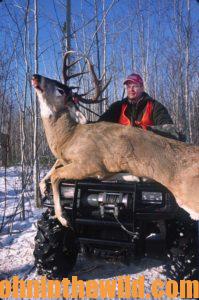 quality knife and some rope and a pulley will enable the hunter to field dress his animal and hang it while he leaves the forest to find help in retrieving his buck. So, with some preparation and forethought along with a quality compass and GPS and a few days of scouting, the hunter who takes the path least used by others, may be the one who finds the biggest and best bucks, while the other hunters are settling for taking the does and smaller bucks with their muzzleloaders.
quality knife and some rope and a pulley will enable the hunter to field dress his animal and hang it while he leaves the forest to find help in retrieving his buck. So, with some preparation and forethought along with a quality compass and GPS and a few days of scouting, the hunter who takes the path least used by others, may be the one who finds the biggest and best bucks, while the other hunters are settling for taking the does and smaller bucks with their muzzleloaders.
T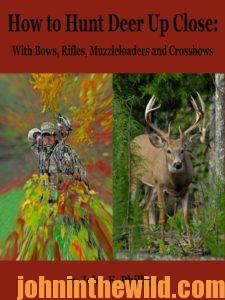 o learn more about hunting deer with black powder, check out John E. Phillips’ book, available in Kindle, print and Audible versions, “How to Hunt Deer Up Close: With Bows, Rifles, Muzzleloaders and Crossbows” (http://amzn.to/11dJRu8).
o learn more about hunting deer with black powder, check out John E. Phillips’ book, available in Kindle, print and Audible versions, “How to Hunt Deer Up Close: With Bows, Rifles, Muzzleloaders and Crossbows” (http://amzn.to/11dJRu8).
Tomorrow: Natural Barriers and Weather Difficulties That Keep Deer from Being Taken




